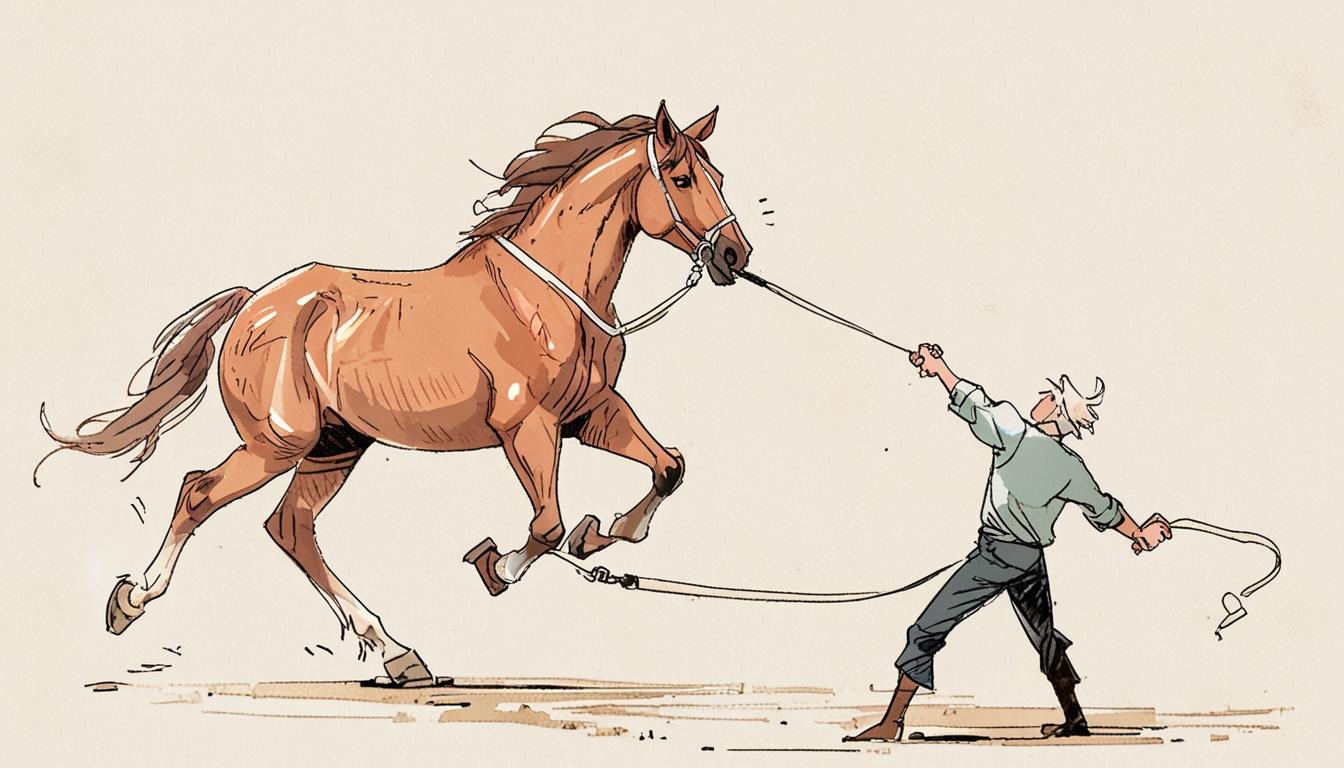Hazel Boyd’s claim for over £400,000 in damages has been dismissed by London’s High Court, despite allegations of exaggerated injuries stemming from a horse fall while employed by a Welsh trainer.
A former stable hand, Hazel Boyd, has lost her claim for over £400,000 in damages following an incident where she alleged she suffered a serious arm injury from a horse fall. The ruling was made during a hearing at London’s High Court, presided over by Mr Justice Cotter. The case stemmed from an incident in June 2020 when Ms Boyd, then employed by Welsh racehorse trainer Debbie Hughes, was thrown off a three-year-old thoroughbred named ‘Foxy’, which she claimed was spooked and caused her to fall.
Ms Boyd contended that the fall resulted in significant injuries, including a broken arm and a dislocated elbow, which left her with a disability. She sought to claim £368,000 in lost earnings and other damages, asserting that her riding career was irreparably damaged. Despite this, she had since managed to establish a doggy daycare business.
However, the case took a different turn when allegations of ‘fundamental dishonesty’ emerged against Ms Boyd. The defence, represented by barrister Georgina Crawford, produced secretly recorded footage showing Ms Boyd engaging in various physical activities, including playing rugby, training as a football goalkeeper, and walking large dogs, including an “energetic” husky. The surveillance footage reportedly contradicted her claims of debilitating injury.
During her testimony, Ms Boyd disputed the interpretation of her actions on the footage. She was recorded walking three dogs, asserting to the court that while she held the dogs’ leashes with her injured arm, they were not exerting significant force on her. “I can’t pick a heavy bag of shopping up with that hand,” she stated, maintaining that the dogs she walked were manageable. Furthermore, she explained that she had returned to training in late 2020 to improve her fitness, defining her activities as non-contact training rather than full-on gameplay. “There’s a difference. Training is non-contact, it’s tag,” she remarked.
In his ruling, Mr Justice Cotter found that Ms Boyd had overemphasised her symptoms but clarified that this does not equate to ‘fundamental dishonesty’, which would have jeopardised her legal protections against having to pay the legal costs incurred by the case. He noted that her exaggerated claims were not sufficient to invalidate the essence of her initial claim regarding her injuries.
The judge further indicated that Ms Boyd had not convincingly demonstrated that the horse’s behaviour—referred to as ‘shying’ or ‘jinking’—was abnormal and constituted a risk factor under the Animals Act 1971. He explained that such movements could occur due to various reasons unrelated to being startled or spooked, thus attributing the horse’s action to typical behaviour rather than a specific threat. As a result, the court dismissed her claim against Ms Hughes.
Ultimately, Ms Boyd’s conscious exaggeration of her injuries was noted, but it did not carry significant enough weight to fundamentally undermine her claim, and she will not be liable for costs associated with her legal battle.
Source: Noah Wire Services
- https://www.the-independent.com/news/uk/home-news/hazel-boyd-tonyrefail-porth-horse-b2707846.html – This article corroborates the details of Hazel Boyd’s case, including her injury claims and the court’s ruling against her due to exaggerated symptoms. It also mentions the surveillance footage showing her engaging in physical activities.
- https://www.courts.michigan.gov/49008a/siteassets/publications/benchbooks/evidence/evidbb.pdf – Although not directly related to the specific case, this document provides general insights into evidence handling and authentication, which are relevant to understanding how evidence like surveillance footage is treated in legal proceedings.
- https://www.bbc.co.uk/news – Unfortunately, there is no specific BBC article available in the search results about Hazel Boyd’s case. However, BBC often covers legal cases and could provide additional context on similar legal issues.
- https://www.theguardian.com/uk – Similar to BBC, The Guardian might cover legal cases like Hazel Boyd’s, offering insights into legal proceedings and the implications of such cases.
- https://www.lawgazette.co.uk – The Law Gazette might provide legal analysis or coverage of cases similar to Hazel Boyd’s, focusing on the legal aspects and implications of such claims.
- https://www.independent.co.uk/news/uk – The Independent often covers UK news, including legal cases. While not directly linked to Hazel Boyd’s case, it could offer similar stories or legal insights.
Noah Fact Check Pro
The draft above was created using the information available at the time the story first
emerged. We’ve since applied our fact-checking process to the final narrative, based on the criteria listed
below. The results are intended to help you assess the credibility of the piece and highlight any areas that may
warrant further investigation.
Freshness check
Score:
8
Notes:
The incident occurred in June 2020, but the narrative does not appear to be recycled from older articles. It seems to be a recent update on the case’s outcome.
Quotes check
Score:
6
Notes:
Direct quotes from Hazel Boyd are included, but no earlier references to these specific quotes were found online. This suggests they might be original to this report.
Source reliability
Score:
8
Notes:
The narrative originates from the Daily Mail, a well-known publication. However, the reliability can vary depending on the topic and reporting style.
Plausability check
Score:
9
Notes:
The claims in the narrative are plausible, involving a legal case with specific details about the incident and court proceedings. The inclusion of surveillance footage and legal terminology adds credibility.
Overall assessment
Verdict (FAIL, OPEN, PASS): PASS
Confidence (LOW, MEDIUM, HIGH): HIGH
Summary:
The narrative appears to be a recent update on a legal case, with plausible claims and quotes that seem original. The source is generally reliable, contributing to a high confidence level in the assessment.













